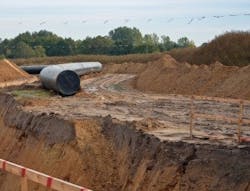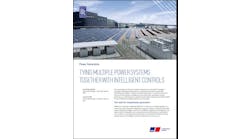Credit: Wikimedia Commons
In energy circles, it’s been a given for years that New England lacks adequate natural gas pipeline. Calls to build more pipeline heightened after natural gas prices soared in the bitter cold winters of 2012/13 and 2013/14.
But a new report sponsored by GDF Suez Energy North America challenges the need for the pipeline, in part because of New England’s aggressive campaign to improve energy efficiency and increase demand response and renewable energy.
“The automatic assumption is that high price signals are indicating the need for new infrastructure. Not in this case,” says the report, “Analysis of Alternative Winter Reliability Solutions for New England Energy Markets,” by Energyzt Advisors.
The report cites several reasons why the pipeline is not needed – any why electric ratepayers should not be required to subsidize it.
Pipeline advocates misread the market dynamics that caused natural gas prices to spike – and with them electricity costs, the report says. Its authors see those winter price spikes as peculiarities caused by a unique set of circumstances that have since changed.
Now the region has more access to liquefied natural gas and additional dual-fuel power generators. Privately built pipeline projects are in the works. ISO New England has added incentives for plants to run during severe cold (rather than sell their sought-after natural gas.) And plans are underway for a new electric transmission line to bring green energy from Canada to New England.
Demand for power flat
But most interesting to us are figures showing a flattening of electricity and natural consumption that may belie need for the natural gas pipeline in New England.
“A new natural gas pipeline is not required now or for at least the next decade under current policies that promote renewables, energy efficiency and demand response given existing and planned energy infrastructure,” said the report.
But if you build it they will come. Flood the market with cheap, subsidized natural gas and a market will arise to use it, likely for export to Canada.
The subsidized pipeline isn’t in keeping with the New England state policy, which has pushed competitive markets and wherever possible green and smart energy alternatives.
These policies appear to be working. New England’s energy appetite is dampening.
ISO New England forecasts growth in energy efficiency from 1,685 MW to 3,579 MW during 2015-2024, a significant chunk in a region where winter peak demand is 22,818 MW. Behind the-meter-solar PV is expected to add another 450 MW.
Adjusted for energy efficiency and solar, the electric consumption growth rate becomes effectively zero over the time frame, the report said.
Forecasts do show an uptick in natural gas consumption in 2017 due to replacement of a retiring coal-fired plant. But after that, natural gas use will steadily decline, the report said.
Look to disruptive energy tech
“Emerging technologies such as distributed generation and battery storage are likely to further moderate peak demand. Government intervention to build a new gas pipeline to supply future natural gas demand from the power sector is inconsistent with these programs,” the report said.
Of course, GDF Suez has a vested interest in opposing the pipeline. The company is the largest LNG supplier in North America and operates over 2,200 MW of renewables in New England and Canada.
But it’s not the only organization pushing alternatives to the subsidized or ‘out-of-market’ pipeline.
In Massachusetts, where state regulators are examining the idea of funding the pipeline through rates paid by electricity customers, several parties say install more energy efficiency and distributed energy resources instead.
In fact, Northeast Energy Efficiency Partnerships pointed out that Massachusetts law requires that before building new infrastructure, the state must try to avert need for more electricity or natural gas through efficiency and demand reduction.
Environmental Entrepreneurs said it foresees 3,000 MW of distributed energy resources coming on line in New England by 2021 – and opportunity for even more. The region has 6,400 MW of combined heat and power potential alone, the group said. New England also is building microgrids, energy storage and other alternatives.
In separate filings before the Massachusetts Department of Public Utilities, the Conservation Law Foundation, the Environmental Defense Fund, the Acadia Center and others also challenged need to subsidize a natural gas pipeline that could cost utility customers in excess of $1 billion.
Energy efficiency alone probably can’t displace the natural gas pipeline. But it’s clearly an important step in doing so. With its tremendous push into efficiency, New England could be the proving ground for one of the resource’s biggest promises. This is an opportunity for energy efficiency to show itself as an influential method for electric grid management, a means to avoid construction of mamouth infrastructure that raises consumer electricity rates for many years.
The full GDF Suez report is available here.
Tell us your thoughts on the proposal to build a subsidized natural gas pipeline in New England. Comment below or on our LinkedIn Group, Energy Efficiency Markets.







